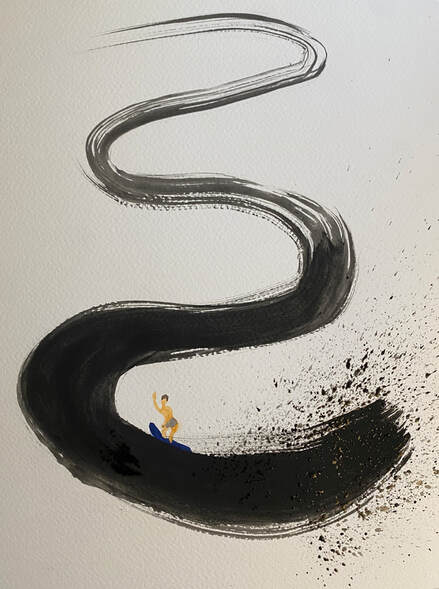To Rest Assured: A Study of Artistic Development Ann-Mari Edström /Lund University, Sweden; Note4/10/2023 To Rest Assured: A Study of Artistic Development Ann-Mari Edström /Lund University, Sweden; NoteArtistic development is certainly the most important part of the goals and objectives of graduate studio education (see presentation of the Swedish Visual Arts Program below). However, it is usually related to children's artistic growth and learning and is rarely investigated and discussed in relation to adults in the context of higher education. There are several reasons behind this discrepancy.
Indeed, there are significant differences between the arts that affect different aspects of learning, including artistic development within the arts (Edström, 1998, 2006). Some practices within the fine arts, eg. Theater and music are usually of an interpretive nature, while others, such as the visual arts, are characterized by works of art originally created by practitioners. This is a crucial gap in understanding learning from a pedagogical point of view. Also, while the practice of theater and music developed educational theories related to those disciplines, there was practically no corresponding development in the field of visual arts. This turns the field of study of visual arts practice into a relatively untapped area of study from an educational theoretical perspective. Because there is no pedagogical frame of reference for learning within the visual arts, teachers have little to consider beyond concepts such as master-apprentice. This is problematic because the concept of master and apprentice has little to do with art education today. The process of becoming an artist today is far more complex than it was in the Middle Ages, when apprenticeships were widespread (cf. Riley, 2007; Singerman, 1999; Sullivan, 1996, 2005). Since the apprentice learns the trade by participating in the master's activities, the core of the apprenticeship system is necessarily the master's practice. In the context of contemporary art education, it is quite the opposite. . Student practice is central to the teacher's activity, a fact that makes the master-apprentice model difficult to apply, and raises the need for alternative teaching references applicable to today's hands-on learning of the visual arts (Edström, 1998). , 2006). This article seeks to contribute to research in the field of visual arts practical learning by adding to an empirical understanding of artistic development and relating these findings to related fields of educational research. . In the 1970s, this research direction was developed through research conducted by Marton, Svensson and colleagues at the University of Gothenburg, Sweden. The term "phenomenography" was coined by Marton in 1981 and denotes an academic approach that aims to describe, analyze, and understand people's experiences or concepts about phenomena and aspects of the world (Marton, 1981 ). The foundations of phenomenology were influenced by Gestalt theory and interest in the nature of the 'whole'. Behaviorism, widely known at the time. Phenomenology provided a source of inspiration for early phenomenology as well. As Giorgi (1999) points out, both phenomenology and phenomenology are qualitative approaches and share an interest in the experience of phenomena. Also, both approaches have a strong interest in learning, but phenomenology assumes a psychological perspective while phenomenology is pedagogically oriented. It is the core of phenomenology to describe and analyze the variation of experiences about phenomena, and categorizing these various ways of experiencing is the result of phenomenological research. On the other hand, phenomenological studies aim to explain the nature and structure of phenomena. Unlike phenomenology (Giorgi, 1999; Svensson, 1986), which proceeds from the philosophy of phenomenology and subordinates data to phenomenological procedures, phenomenology begins with data and subordinates procedures to data. The authors regard the phenomenological view of learning as a powerful alternative to the more general constructivist view, and it is characterized by the creation of new ones, especially in the context of visual arts practice (Edström, 2006). From a phenomenological point of view, an individual's phenomenon experience is understood as an 'internal relationship' between the experiencing subject and the experiencing object. Consequently, learning is defined as a qualitative change in the relationship between subject and object of experience (Johansson, Marton & Svensson, 1985; Marton & Booth, 1997; Marton, Dahlgren, Svensson & Säljö, 1977; Svensson, 1984, 1997). . The structural view of learning has certain limitations when it comes to explaining the creation of the new and invisible (Edström, 2006; cf. Nielsen, 2006). In short, two of the dominant constructivist views on learning, the cognitive school and the sociocultural school, both have what Marton and Booth (1997) call a 'paradoxical' understanding of knowledge development. The essence of the paradox is that the learner must have prior knowledge about something new, i.e., about the unknown. This paradox is closely related to the inside-outside dualism of the human mind, embraced by cognitive as well as sociocultural views of knowledge (see Edström, 2006; Efland, 2002; Marton, 1995; Marton for a broader critique). ). & Booth, 1997). On the other hand, the phenomenological view of learning removes the paradox of the dualistic view of knowledge by focusing on the change in the relationship between subject and object in describing the development of knowledge. Methods The study presented here is based on empirical investigations conducted in the period 2001-2007. A group of students from the Swedish Visual Arts MFA program were interviewed during their five-year training period. Each student is assigned her own studio and her education is characterized by freedom of choice, which requires a lot of self-direction from the student. The program offers both practical and theoretical courses. While the curriculum and course content offered may differ somewhat between the five programs, they are similar in their focus on the student's own work. Some programs may have explicit profiles, but nonetheless they all share the same core goals and objectives. The methodological assumptions embedded in phenomenology have been explained as follows. “The most central characteristics are the exploratory nature of data collection and the contextual analysis nature of data processing” (Svensson, 1997, p. 169). As Williams (2000) observes, “the nature of art is often solitary and individual, and as a result artists naturally tend toward self-directed learning methods. models" (p. 1). Since contemporary art has no restrictions on content or form, each classification is up to the artist. Regarding Tremblay's personal control over "content, objectives, resources, processes, and assessment" (Tremblay 2000, p. 210), this is indeed learning with a very high degree of personal autonomy and learner control, a kind of 'supervised automatic It is 'learning'. ' (cf. Candy, 1994). The ideas of Bowden and Marton (1998) were later elaborated in Bowden (2004), where he seems to have developed a more genuine approach to the unexpected and invisible. He emphasizes the importance of respecting the different ways students see rather than dismissing them as inaccurate, giving students the opportunity to self-evaluate their experiences. The revised concept of 'capacity for knowledge' approaches the original epistemological underpinnings of phenomenology (see Webb's critique of phenomenology in 1997a; 1997b). Additionally, Bowden now approaches the core of learning in visual arts practice by embracing self-direction and the ability to process the uncertain/unknown. Process a real situation that you couldn't see before, understand it, figure out what the relevant aspects are, relate it to what you know, don't know but [. ..], to define a problem and then solve it, this is what I call knowledge competence. (p.40) A student's prior learning experience, along with the student's perception of their situation, their approach to learning and learning outcomes, are four simultaneously existing and successive factors that must be considered when addressing the learning situation from the student's point of view. Prosser and Trigwell emphasize that what should be the focus is the student's awareness of his or her prior understanding (of the subject content and learning situation). They list four principles to consider in teaching situations to support student learning. 1. Students practically enter our learning and teaching context. Qualitative differences in previous experiences with learning and teaching. 2. These prior experiences of learning and teaching are related to the specific prior circumstances in which they occurred. 3. The new learning and teaching situation they find themselves in evokes certain aspects of these prior experiences, and the evoked aspects relate to the congruence between the old and new situations. 4. Does the evoked aspect have a practical impact on what and how next? Students learn in new situations To contribute to a comprehensive understanding of artistic development by focusing on the changing relationship between the student and his artistic work as part of the student's artistic development. To explain this qualitative change, the concept of 'security' was introduced, which refers to a state of confidence and security that is the basis for students' firm confidence in their abilities. These changes can be seen in relation to three aspects: the intimacy of the artwork, the uncertainty, and the working process. At the same time, there are traces of an informal agenda that says that students who cannot handle extreme self-direction are not suitable to be artists, that is, that schools should not be too active in helping students through this adaptation process. A more fruitful pedagogical approach might be to encourage students and teachers to reflect and discuss learning situations and processes. Analysis suggests that self-direction clearly promotes the development of intimacy and the ability to feel reassured in the work process.
0 Comments
Leave a Reply. |
Myungja Anna KohArtist Categories
All
Archives
July 2024
|
Proudly powered by Weebly


 RSS Feed
RSS Feed